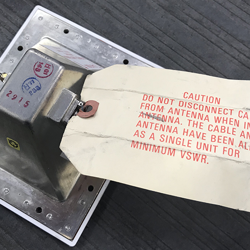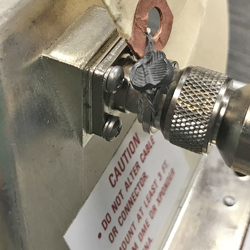| Part #: | 071-1114-00 |
|---|---|
| Model: | KA-131 |
| Desc: | Radio Altimeter Antenna |
| OEM: | BendixKing |
| NSN: | 5985-01-356-0653 |
|---|---|
| Sched-B: | 8529104000 |
| ECCN: | 6A998A |
| Cage Code: | 22373 |
 Select part number above to view pricing and availability.
Select part number above to view pricing and availability.
| Price | Condition | Availability | Stock Info | |
|---|---|---|---|---|
| Price | Cond. | Avail. | Stock Info | |
| $1,795.00 | SV OUTRIGHT | REQUEST LEAD TIME |
|
| Price | Condition | Availability | Stock Info | |
|---|---|---|---|---|
| Price | Cond. | Avail. | Stock Info | |
| $2,395.00 | SV OUTRIGHT | REQUEST LEAD TIME |
|

KA-131
FEATURES
- Radar altimeter antenna used in KRA-10/10A Radar Altimeter System
- Available in standard configuration designed to be mounted on a metal surface where front to back angle is parallel with the ground within +/-6 degrees during level flight(see table below)
- Available in skewed configuration designed to be mounted on a metal surface where the front to back angle is parallel with the ground within 6 to 20 degrees during level flight (see table below)
SPECIFICATIONS
| Size: | 5.06"W x 2.66"H x 6.06"L | Weight: | 0.9 lbs. |
| Altitude: | 45000 feet | Temperature: | -55 to +71C |
| Beamwidth: | E-Plane= 40 +-5 deg. ; H-Plane= 40 +-5 deg. | Side Lobe: | 20dB down |
| Gain Above Isotropic: | 10.5dB minimum | Polarization: | Linear |
| Input Impedance: | 50 ohm nominal | Skew: | 0-6 deg. (-00 unit); 6-20 deg. (-01 unit) |
| Part Number: | Description: |
|---|---|
| 071-1114-00 | Standard configuration, Radio Altimeter Antenna |
| 071-1114-01 | Skewed configuration, Radio Altimeter Antenna |
| Serial # | KA131-A16021 |
|---|---|
| Condition | NEW |
| Mods | - |
| Tag Date | 09/12/19 |
| Shop | Honeywell International Inc. |
| Warranty | 1 Year |
| Serial # | KA131-A16014 |
|---|---|
| Condition | NEW |
| Mods | - |
| Tag Date | 08/05/19 |
| Shop | Honeywell International Inc. |
| Warranty | 1 Year |
| Serial # | KA131-A16015 |
|---|---|
| Condition | NEW |
| Mods | - |
| Tag Date | 08/05/19 |
| Shop | Honeywell International Inc. |
| Warranty | 1 Year |
| Serial # | KA131-A16016 |
|---|---|
| Condition | NEW |
| Mods | - |
| Tag Date | 08/05/19 |
| Shop | Honeywell International Inc. |
| Warranty | 1 Year |
NSN: 5985-01-356-0653
| Price | Condition | Status |
|---|---|---|
| $1,795.00 | SV OUTRIGHT | REQUEST LEAD TIME |
| Price | Condition | Status |
|---|---|---|
| $2,395.00 | SV OUTRIGHT | REQUEST LEAD TIME |
Click on a question below to see the answer. If you have a question about this model that is not answered below, please contact questions@seaerospace.com
Why do some parts indicate "REQUEST" or “RFQ” on the Southeast Aerospace website?
In relation to NE (New) parts, many OEMs change their prices and availability without any notice to dealers or the industry. Therefore, through the REQUEST or RFQ indication, we ask that customers contact us for the most accurate price and availability.
In relation to SV & OH parts, the used parts aftermarket in the aviation industry is not an infinite supply. It is a dynamic, constantly changing market that is significantly affected by and susceptible to highs and lows in supply and demand. Therefore, although we attempt to, at times, we are unable to predict the exact moment when an item may be available. Once again, through the REQUEST or RFQ indication on our website, we ask that customers contact us for the most current and accurate price and availability.
Why should the cable assembly on the KA-131 not be removed?
The coaxial cable connected to the KA-131 is fitted and matched at the original time of manufacturing. The cable and antenna are aligned as a single unit for minimum SWR. A tag stating this requirement is attached to the antenna however it may become detached at some point in the life cycle of the antenna. A label was placed on the antenna as well stating to not alter the cable. The cable is safety wired onto the antenna to further prevent someone from removing the cable from the antenna. Please see images for refernence.


What is the difference between Honeywell (Bendix/King) part numbers with 9 digits vs. 12 digits?
Why did Bendix/King change their part numbers from a 9 digit to a 12 digit format?
Different software versions imply different operational features and/or interface capabilities and software modifications imply software repairs (bug fixes) to insure proper operation of these features and interfaces. Software version upgrades frequently require hardware modifications to the unit. Such hardware modifications accompanying software version upgrades do not necessarily change the hardware version of the unit.



